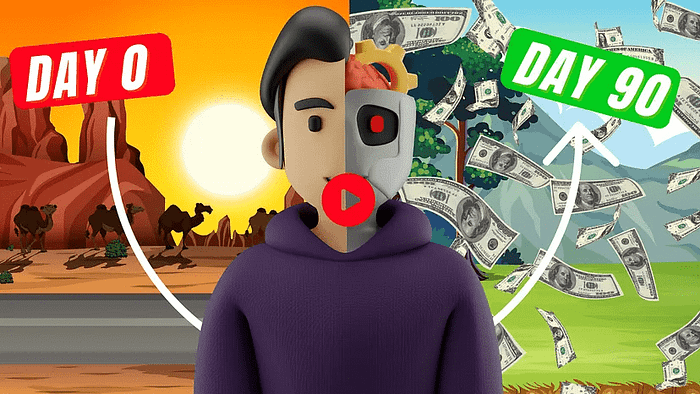Top 10 Innovative Future Marketing Trends Shaping Business Success in 2025
Future marketing trends are reshaping the business landscape, and staying ahead of the curve is crucial for success. As we approach 2025, the marketing world is undergoing a seismic shift, driven by technological advancements and changing consumer behaviors.
In this comprehensive guide, I’ll explore the top 10 marketing trends that will dominate the industry in 2025. From innovative strategies to cutting-edge technologies, these future marketing trends will revolutionize how businesses connect with their audiences and drive growth.
Let’s dive into these game-changing trends that are set to redefine the marketing landscape in the coming years.
We strongly recommend that you check out our guide on how to take advantage of AI in today’s passive income economy.
Table of Contents
1. TikTok SEO: The New Frontier of Search
The Shift from Traditional Search Engines to Social Media
Future marketing trends are pointing towards a significant shift in how people search for information. Surprisingly, social media platforms are now outpacing traditional search engines in terms of user engagement.
Recent statistics show that 94.6% of internet users between ages 16 and 64 visited a social networking site in the last month, compared to only 81.8% who visited a search engine. This shift is particularly pronounced among younger generations, with 44% of Gen Z and 33% of Millennials turning to social media for product information.
The Rise of Social Search Optimization
As future marketing trends evolve, social search optimization is becoming a critical component of digital marketing strategies. Nearly 90% of marketers now consider social optimization a vital part of their overall approach.
This trend involves optimizing content for social media platforms by:
- Using relevant hashtags
- Adding alt text to images
- Placing keywords in captions
- Creating easily discoverable content
TikTok Search Ads: A Game-Changer in Social Advertising
One of the most exciting future marketing trends is the emergence of TikTok Search Ads. Launched in 2023, these ads appear within organic search results on the platform, offering a unique way to reach potential customers.
TikTok reports that search ads can boost performance significantly, with 70% of ad groups achieving lower cost per acquisition compared to those without search ads. For example, beauty brand Clinique saw a staggering 441% increase in conversions using TikTok search ads.
Adapting to the Social Search Landscape
As future marketing trends continue to evolve, businesses must adapt their strategies to meet customers where they are – on social media. This shift presents an unprecedented opportunity for marketers to organically capture, educate, entertain, and sell to their audience all in one place.
To stay ahead in 2025, it’s crucial to prioritize social SEO and explore innovative advertising options like TikTok Search Ads.
2. Personalized Marketing: The Future of Customer Engagement
The Power of Tailored Experiences
Future marketing trends are increasingly focused on personalization. As technology and AI continue to advance, creating tailored experiences for customers is becoming not just possible but essential.
In the past five years, searches for personalized marketing have doubled, indicating a growing interest in this approach. The effectiveness of personalization is clear: 80% of consumers are more likely to make a purchase when brands offer personalized experiences.
The Value of Personal Data
One of the most intriguing future marketing trends is consumers’ willingness to share personal information in exchange for better shopping experiences. A staggering 90% of shoppers are open to sharing their data if it means they’ll enjoy cheaper or more convenient shopping.
Augmented Reality and Personalization
Future marketing trends are seamlessly blending personalization with augmented reality (AR) technologies. For instance, Crate & Barrel’s “View in My Room” feature allows customers to visualize furniture in their own spaces before making a purchase.
This type of AR-powered personalization is proving highly effective. The Ride a Personalized Commerce study revealed that 70% of businesses using personalized marketing reported a 200% ROI.
AI-Driven Hyper-Personalization
As we look towards 2025, one of the most exciting future marketing trends is the use of AI to deliver hyper-personalized product recommendations. These recommendations will be based on real-time data and tailored to individual preferences, creating a truly unique shopping experience for each customer.
To leverage these future marketing trends, businesses should:
- Analyze their customer data
- Identify opportunities for personalization
- Explore AR and AI technologies to enhance the customer experience
By embracing personalization, companies can create more engaging, relevant, and effective marketing campaigns that resonate with their target audience.
3. AI-Powered Customer Support: Meeting Rising Expectations
The Demand for Instant Responses
Future marketing trends indicate a growing expectation for immediate customer support. According to Zendesk, over 72% of consumers expect an instant response from businesses they contact. However, only 56% of consumers felt positive about their customer support interactions in the past year.
This gap between expectation and reality presents both a challenge and an opportunity for businesses as they navigate future marketing trends.
Social Media as a Customer Support Channel
One of the emerging future marketing trends is the shift towards providing customer support on social media platforms. The Sprout Social Index found that 51% of consumers believe the most memorable brands are those that respond to customers on social media.
Brands like Spindrift are leading the way in this trend, often replying to customer queries on platforms like X (formerly Twitter) within minutes. Their responses strike a balance between being helpful and maintaining a laid-back, humorous tone that aligns with their brand personality.
The Rise of AI Chatbots
As businesses strive to meet the demand for 24/7 support, AI chatbots are becoming an integral part of future marketing trends. These chatbots can provide instant responses, handling a wide range of customer queries efficiently and effectively.
A recent survey found that 40% of consumers are interested in using chatbots, and 80% of those who have interacted with a chatbot reported a positive experience. This positive reception is driving the adoption of chatbots across various industries.
Implementing AI in Customer Support
For businesses looking to stay ahead of future marketing trends, implementing AI in customer support should be a priority. Here are some key considerations:
- Evaluate your current response times and customer satisfaction rates
- Explore AI chatbot solutions that align with your brand voice and customer needs
- Consider integrating chatbots with your social media channels for seamless support
- Continuously train and improve your AI systems based on customer interactions
By embracing AI-powered customer support, businesses can meet rising consumer expectations, improve satisfaction rates, and stay competitive in an increasingly fast-paced market.
4. User-Generated Content: Building Trust and Engagement
The Power of Authentic Content
Future marketing trends are increasingly emphasizing the importance of user-generated content (UGC). As consumer trust in traditional advertising wanes, UGC is becoming a crucial tool for building credibility and driving conversions.
Recent studies show that shoppers are 2.4 times more likely to view UGC as authentic compared to branded content. This authenticity translates directly into purchasing decisions, with 79% of consumers stating that UGC has the highest impact on their buying choices.
The Demand for UGC
One of the most significant future marketing trends is the growing consumer demand for UGC. In fact, 56% of consumers say that user-generated content is the main type of content they want to see from brands. This preference for UGC surpasses professionally branded images and even celebrity endorsements.
Encouraging UGC Across Industries
Future marketing trends suggest that consumers are eager to share their positive experiences across various industries. For example:
- 89% would create content about travel destinations after a positive experience
- 85% are happy to share content about their favorite restaurants
- 65% would create content about beauty products
- 62% would share content about their cars
Implementing UGC Strategies
To leverage this powerful future marketing trend, businesses should consider the following strategies:
- Identify key messages: Determine the main points you want to communicate about your product or service
- Provide guidelines: Give clear instructions to UGC creators while allowing room for authenticity
- Encourage sharing: Create campaigns that motivate customers to share their experiences
- Showcase UGC: Feature user-generated content prominently in your marketing materials and social media channels
By embracing UGC, brands can tap into a wealth of authentic, trustworthy content that resonates with their audience and drives engagement.
5. YouTube Ads: The Advertising Giant of 2025
The Growing Dominance of YouTube Advertising
Future marketing trends point to YouTube as a major player in the advertising landscape. With a 126% growth in search interest for YouTube ads over the past five years and global revenue reaching $8 billion per quarter, the platform is poised to become an advertising giant by 2025.
Unparalleled Reach and Effectiveness
One of the most compelling future marketing trends is the potential reach of YouTube ads. Digital marketers using the platform can potentially connect with 1.7 billion new users every month. This vast audience, combined with YouTube’s sophisticated targeting options, makes it an increasingly attractive option for advertisers.
Success Stories and ROI
Several brands have already experienced significant success with YouTube ads, demonstrating why this is one of the key future marketing trends to watch:
- Grammarly: The cloud-based typing assistant used YouTube’s full-funnel ad strategy, focusing on long-term brand building and customer acquisition. The result was a 9% higher ROI compared to traditional awareness ads and a 133% increase in conversions with the same ad budget.
- Kayak: The travel company launched a series of humorous ads on YouTube’s connected TV platform. The campaign reached one in four US adults within a month and increased conversion rates by 7.5%.
Leveraging YouTube Ads in Your Marketing Strategy
To capitalize on this future marketing trend, consider the following strategies:
- Create engaging video content that aligns with your brand message
- Utilize YouTube’s various ad formats, including skippable in-stream ads, non-skippable in-stream ads, and bumper ads
- Take advantage of YouTube’s targeting options to reach your ideal audience
- Experiment with different ad lengths and styles to find what resonates best with your viewers
- Use YouTube Analytics to track performance and optimize your campaigns
By incorporating YouTube ads into your marketing mix, you can tap into a powerful platform that offers both broad reach and precise targeting capabilities.
6. AI Chatbots: Revolutionizing Customer Interactions
The Growing Acceptance of Chatbots
As we look towards future marketing trends, AI chatbots are emerging as a crucial tool for businesses. A recent survey found that 40% of consumers are interested in using chatbots, with 80% reporting positive experiences from their interactions.
This growing acceptance is driving the adoption of chatbots across various industries, making it one of the most important future marketing trends to watch.
Chatbots in B2B Marketing
The impact of chatbots extends beyond consumer-facing businesses. In the B2B sector, 82% of marketers consider AI chatbots a valuable addition to their sales and marketing strategies. This widespread adoption underscores the versatility and effectiveness of chatbots across different business models.
WhatsApp: A Platform for Chatbot Marketing
One of the most exciting future marketing trends is the use of chatbots on messaging platforms like WhatsApp. With over 2 billion global users, WhatsApp offers a massive audience for businesses to engage with through chatbots.
Marketers are using WhatsApp chatbots to:
- Send reminders to customers
- Introduce cross-selling opportunities
- Deliver targeted promotions
For example, Tata CLiQ, a luxury e-commerce brand in India, launched a chatbot marketing campaign on WhatsApp in 2021. The results were impressive:
- 57% click-through rate on WhatsApp communications
- $500,000 in sales attributed to the app in one month
- 10 times higher ROI compared to their normal marketing channels
The Rise of Accessible Chatbots
While complex AI chatbots are becoming more prevalent, there’s also a growing demand for simpler, more accessible chatbot solutions. Platforms like Landbot are catering to this need by offering easy-to-use chatbot creation tools based on decision tree systems.
This trend towards accessible chatbots is making it easier for businesses of all sizes to implement chatbot technology and stay competitive in the evolving digital landscape.
Implementing Chatbots in Your Business
To leverage this future marketing trend, consider the following steps:
- Assess your customer support needs and identify areas where chatbots could improve efficiency
- Choose a chatbot platform that aligns with your technical capabilities and business goals
- Design your chatbot to reflect your brand voice and provide valuable assistance to customers
- Continuously monitor and optimize your chatbot’s performance based on user interactions and feedback
By embracing AI chatbots, businesses can improve customer satisfaction, increase efficiency, and stay ahead in the competitive landscape of 2025.
7. Influencer Marketing Platforms: Scaling Your Reach
The Booming Influencer Economy
Future marketing trends indicate a significant shift towards influencer marketing. With influencer spending growing 3.5 times faster than social ad spend and expected to increase by at least 14% by 2025, it’s clear that this strategy is becoming increasingly important for businesses.
In 2023, businesses spent an estimated $2 billion on influencer marketing, and 65% of companies plan to increase their influencer marketing budget in the coming years.
The Rise of Influencer Marketing Platforms
As influencer marketing becomes more prevalent, one of the key future marketing trends is the emergence of specialized platforms designed to streamline the process. These platforms aim to solve one of the biggest challenges in influencer marketing: finding the right influencers for your brand.
Two notable examples of these platforms are:
- Sparktoro: This software helps businesses quickly identify YouTube channels, podcasts, and personal brands that their target audience follows.
- Upfluence: A database containing over 3 million influencers, allowing users to search, sort, and directly contact potential collaborators.
Benefits of Influencer Marketing Platforms
These platforms offer several advantages that align with future marketing trends:
- Time-saving: Quickly identify relevant influencers without manual searching
- Data-driven decisions: Access detailed metrics about influencers and their audiences
- Streamlined outreach: Many platforms offer built-in communication tools
- Campaign management: Track and measure the success of your influencer campaigns
Implementing Influencer Marketing Strategies
To leverage this future marketing trend effectively, consider the following steps:
- Define your goals: Determine what you want to achieve with influencer marketing
- Identify your target audience: Understand which influencers resonate with your ideal customers
- Choose the right platform: Select an influencer marketing platform that aligns with your needs and budget
- Develop authentic partnerships: Focus on building long-term relationships with influencers who genuinely connect with your brand
- Measure and optimize: Use the data provided by these platforms to continuously improve your influencer marketing efforts
By embracing influencer marketing platforms, businesses can scale their reach, connect with new audiences, and stay competitive in the evolving digital landscape of 2025.
8. Niche Email Marketing: Personalized Communication at Scale
The Evolution of Email Marketing
As we look towards future marketing trends, email marketing is undergoing a significant transformation. While it remains a powerful tool for customer engagement, the landscape is shifting towards more specialized, niche-focused platforms.
This trend is driven by the need for more personalized, targeted communication that caters to specific audience segments or use cases.
The Rise of Niche Email Marketing Platforms
One of the most exciting future marketing trends is the emergence of email marketing platforms that focus on specific features or user groups. These platforms are challenging traditional, one-size-fits-all solutions by offering tailored experiences for different types of users.
Some examples of these niche platforms include:
- Substack: Focused on paid newsletter subscriptions, Substack has seen a staggering 4,550% search growth over the last five years. Its unique pricing model, which takes a percentage of user revenue instead of charging a flat fee, has made it popular among content creators.
- Sendfox: Designed specifically for content creators who may neglect their email lists, Sendfox offers a simple, aesthetically pleasing solution for building and maintaining subscriber relationships.
The Importance of Owned Audiences
One of the key drivers behind these future marketing trends is the growing recognition of the importance of owned audiences. As social media algorithms become increasingly unpredictable, having direct access to your audience through email is becoming crucial for business sustainability.
Email marketing remains the only digital channel that businesses can fully control, making it an essential tool for protecting and nurturing customer relationships.
Implementing Niche Email Marketing Strategies
To leverage these future marketing trends effectively, consider the following strategies:
- Identify your niche: Determine the specific needs and preferences of your target audience
- Choose the right platform: Select an email marketing tool that aligns with your audience and content type
- Focus on personalization: Use the specialized features of niche platforms to create highly targeted campaigns
- Build your list: Implement strategies to grow your email subscriber base
- Provide value: Create content that resonates with your specific audience segment
- Analyze and optimize: Use the analytics provided by these platforms to continually improve your email marketing efforts
By embracing niche email marketing platforms, businesses can create more engaging, personalized communication strategies that drive customer loyalty and business growth.
9. SMS Marketing: The Resurgence of Direct Communication
The Growing SMS Marketing Landscape
Future marketing trends indicate a significant resurgence in SMS marketing. The US SMS marketing industry is projected to reach $12.6 billion by 2025, up from $5 billion in 2020. This explosive growth underscores the effectiveness of SMS as a direct communication channel.
The Power of SMS Open Rates
One of the most compelling reasons for the rise of SMS in future marketing trends is its unparalleled open rates. As of 2016, the average SMS open rate was an astounding 98%, more than four times higher than the average email open rate of 21%. This high engagement rate makes SMS an attractive option for marketers looking to ensure their messages are seen and acted upon.
Leading Platforms in SMS Marketing
As SMS marketing gains prominence in future marketing trends, several platforms are emerging as leaders in this space:
- Twilio: Offers a comprehensive cloud communications platform that includes API-based SMS marketing functions, along with email, phone calls, and chatbot capabilities.
- MessageBird: A Netherlands-based company that supports voice, WhatsApp, and other platforms. They raised $200 million in Series C funding in 2020, reaching a $3 billion valuation.
- Yotpo, Attentive, and Emotive: These platforms are specifically designed for e-commerce businesses looking to leverage SMS marketing. They have all secured significant funding, with Attentive raising an impressive $863 million.
Implementing SMS Marketing Strategies
To capitalize on these future marketing trends, consider the following strategies:
- Obtain explicit consent: Ensure you have permission to send SMS messages to your customers
- Personalize your messages: Use customer data to create targeted, relevant SMS campaigns
- Timing is key: Send messages at optimal times to maximize engagement
- Keep it concise: Craft clear, concise messages that provide value to the recipient
- Include clear calls-to-action: Make it easy for recipients to take the next step
- Integrate with other channels: Use SMS as part of a multi-channel marketing strategy
- Measure and optimize: Track key metrics like open rates, click-through rates, and conversions to continually improve your SMS marketing efforts
By incorporating SMS marketing into your overall strategy, you can leverage one of the most direct and effective communication channels available to marketers in 2025.
10. Short-Form Content: Capturing Attention in a Fast-Paced World
The Shrinking Attention Span
One of the most significant future marketing trends is the continuing decrease in audience attention spans. Recent research shows that the average attention span on electronic devices has dropped from 2.5 minutes in the early 2000s to just 47 seconds today. For Gen Z, this window is even shorter, with focus on ads lasting only 1.3 seconds.
The Rise of Short-Form Video
In response to these changing attention patterns, short-form video has emerged as a dominant force in future marketing trends. Platforms like TikTok and Instagram are seeing tremendous success with brief, engaging content:
- TikTok data shows that videos between 11 to 17 seconds are the most successful
- Instagram users prefer reels between 7 and 15 seconds
YouTube Shorts: A Growing Platform for Short-Form Content
As part of these future marketing trends, YouTube Shorts has quickly become a go-to platform for short-form content. With 2 billion monthly active users, it offers a massive audience for marketers looking to leverage brief, engaging videos.
Strategies for Creating Effective Short-Form Content
To capitalize on these future marketing trends, consider the following approaches:
- Focus on the hook: Capture attention in the first few seconds of your video
- Provide value: Offer information, entertainment, or solutions that resonate with your audience
- Be authentic: Create content that feels genuine and aligns with your brand voice
- Use visual storytelling: Leverage visuals to convey your message quickly and effectively
- Optimize for sound-off viewing: Use captions or text overlays to ensure your message is understood even without sound
- Encourage engagement: Include calls-to-action that prompt viewers to interact with your content
- Leverage trending topics: Stay current by participating in popular trends or challenges
- Repurpose content: Adapt longer-form content into bite-sized pieces for short-form platforms
Balancing Short-Form with Other Content Types
While short-form content is a crucial part of future marketing trends, it’s important to maintain a balanced content strategy. Longer-form content still has its place, particularly for in-depth explanations, detailed product demonstrations, or building deeper connections with your audience.
By embracing short-form content while maintaining a diverse content mix, businesses can effectively capture attention in today’s fast-paced digital landscape while still providing comprehensive information when needed.
Conclusion
As we look towards 2025, these future marketing trends are set to reshape how businesses connect with their audiences. From the rise of TikTok SEO to the power of short-form content, each trend offers unique opportunities for marketers to innovate and engage.
To stay competitive in this rapidly evolving landscape, it’s crucial to:
- Embrace social search optimization
- Leverage personalization and AI technologies
- Prioritize user-generated content
- Explore niche marketing platforms
- Adapt to shorter attention spans with compelling, bite-sized content
By staying ahead of these future marketing trends, businesses can create more effective, engaging, and successful marketing strategies that resonate with their target audiences in 2025 and beyond.
Remember, the key to success in this dynamic environment is to remain flexible, continuously learn, and be willing to experiment with new approaches. As these future marketing trends evolve, so too should your marketing strategies, ensuring your brand remains relevant and competitive in the years to come.

We strongly recommend that you check out our guide on how to take advantage of AI in today’s passive income economy.




